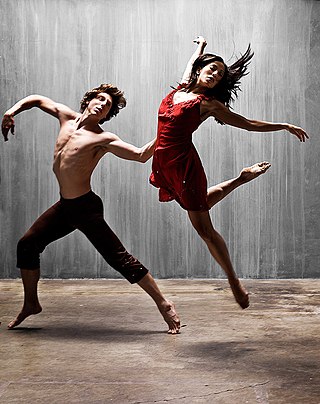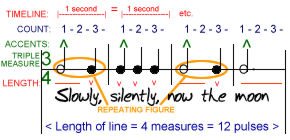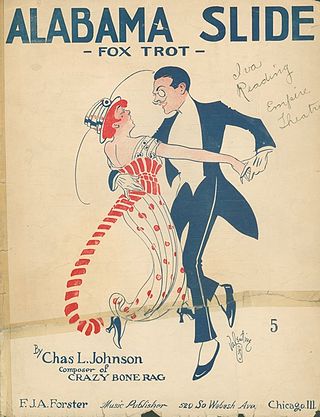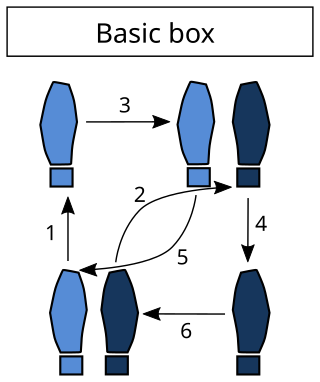
Ballroom dance is a set of European partner dances, which are enjoyed both socially and competitively around the world, mostly because of its performance and entertainment aspects. Ballroom dancing is also widely enjoyed on stage, film, and television.

Dance is an art form, often classified as a sport, consisting of sequences of body movements with aesthetic and often symbolic value, either improvised or purposefully selected. Dance can be categorized and described by its choreography, by its repertoire of movements or by its historical period or place of origin. Dance is typically performed with musical accompaniment, and sometimes with the dancer simultaneously using a musical instrument themselves.
In music, syncopation is a variety of rhythms played together to make a piece of music, making part or all of a tune or piece of music off-beat. More simply, syncopation is "a disturbance or interruption of the regular flow of rhythm": a "placement of rhythmic stresses or accents where they wouldn't normally occur". It is the correlation of at least two sets of time intervals.

The waltz, meaning "to roll or revolve") is a ballroom and folk dance, normally in triple, performed primarily in closed position.

In music, metre or meter refers to regularly recurring patterns and accents such as bars and beats. Unlike rhythm, metric onsets are not necessarily sounded, but are nevertheless implied by the performer and expected by the listener.

The foxtrot is a smooth, progressive dance characterized by long, continuous flowing movements across the dance floor. It is danced to big band music. The dance is similar in its look to waltz, although the rhythm is in a 4
4 time signature instead of 3
4. Developed in the 1910s, the foxtrot reached its height of popularity in the 1930s and remains practiced today.
Bossa nova is a relaxed style of samba developed in the late 1950s and early 1960s in Rio de Janeiro, Brazil. It is mainly characterized by a "different beat" that altered the harmonies with the introduction of unconventional chords and an innovative syncopation of traditional samba from a single rhythmic division. The "bossa nova beat" is characteristic of a samba style and not of an autonomous genre. The bossa nova wave became popular around the world; this increased popularity helped to renew samba and contributed to the modernization of Brazilian music in general.

Modern social round dance, or round dancing, is a choreographed and cued ballroom dance that progresses in a circular counter-clockwise pattern around the dance floor. The two major categories of ballroom dances found in round dancing are the smooth and international ballroom styles and the Latin dances. It is not to be confused with circle dancing, which is a type of folk dance in which dancers are connected in a circular chain.
This is a list of dance terms that are not names of dances or types of dances. See List of dances and List of dance style categories for those.

Samba is a lively dance of Afro-Brazilian origin in 2/4(2 by 4) time danced to samba music.
Rhumba, also known as ballroom rumba, is a genre of ballroom music and dance that appeared in the East Coast of the United States during the 1930s. It combined American big band music with Afro-Cuban rhythms, primarily the son cubano, but also conga and rumba. Although taking its name from the latter, ballroom rumba differs completely from Cuban rumba in both its music and its dance. Hence, authors prefer the Americanized spelling of the word (rhumba) to distinguish between them.

Box step is a basic dance step named after the pattern it creates on the floor, which is that of a square or box. It is used in a number of American Style ballroom dances: rumba, waltz, bronze-level foxtrot. While it can be performed individually, it is usually done with a partner. This is the most common dance step in the waltz. In international standard dance competition, there is a similar step called closed change.
The basic step, basic figure, basic movement, basic pattern, or simply basic is the dance move that defines the character of a particular dance. It sets the rhythm of the dance; it is the default move to which a dancer returns, when not performing any other moves. More formally, it can be defined as a "rhythmic step pattern" in the form of a "consistent and recurring grouping of weight changes" between the feet which is rhythmic and repeated for the length of a song. For some dances it is sufficient to know the basic step performed in different handholds and dance positions to enjoy it socially.

The cha-cha-cha, is a dance of Cuban origin. It is danced to the music of the same name introduced by the Cuban composer and violinist Enrique Jorrin in the early 1950s. This rhythm was developed from the danzón-mambo. The name of the dance is an onomatopoeia derived from the shuffling sound of the dancers' feet when they dance two consecutive quick steps that characterize the dance.
Samba de Gafieira is a partner dance to various Brazilian samba musical rhythms. Unlike street and club forms of Brazilian samba, it evolved as a ballroom dance.

Sequence dancing is a form of dance in which a preset pattern of movements is followed, usually to music which is also predetermined. Sequence dancing may include dances of many different styles. The term may include ballroom dances which move round the floor as well as line, square and circle dances.

Bachata is a style of social dance from the Dominican Republic which is now danced all over the world. It is connected with bachata music.
The Collegiate Shag is a partner dance done primarily to uptempo swing and pre-swing jazz music. It belongs to the swing family of American vernacular dances that arose in the 1920s and 30s. It is believed that the dance originated within the African American community of the Carolinas in the 1920s, later spreading across the United States during the 1930s. The shag is still danced today by swing dance enthusiasts worldwide.











